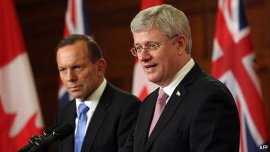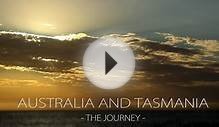

BEFORE the financial crisis, gambling on resource extraction seemed to be a one-way bet for the Australian and Canadian governments. During the commodities super-cycle of the mid-2000s, China absorbed new supplies of metals and energy as quickly as projects could be brought on stream, keeping global prices high. Boom towns sprung up in Alberta in Canada and Western Australia to house miners and builders constructing expensive pipelines and terminals. Only last year the Australian prime minister, Tony Abbott (pictured on the left), announced that coal was “good for humanity” as he opened a mine in Queensland.
But times have changed. Commodity prices are falling. Iron ore, oil and coal are all trading at less than half of their prices in 2011. This is causing problems for governments of developed nations that have relied on mining and energy sectors for growth in recent years. Canada, the world’s fourth-largest oil exporter, is now in recession, thanks to lower spending on machinery and equipment for the energy sector. Growth has also slowed to a crawl in Australia: exports in the second quarter subtracted a hefty 0.7 percentage points from growth, because Australia’s terms of trade—the ratio of export prices to import prices—have fallen by more than 10% since mid-2014.
Yet investment in the mining sector is not quite as weak as many economists once predicted. Falling prices has not deterred Gina Rinehart, a mining magnate and Australia’s richest person, from developing a iron-ore project, Roy Hill, costing $13 billion, with an estimated annual production of 55m tonnes: more than is dug up from the entire North American continent each year. Exporting ever higher volumes during a supply glut will push global prices down further. Ms Rinehart is hoping that Roy Hill’s economies of scale will force smaller miners out of business—and that this happens quickly enough for her investors to see returns. But that may be just moving future investment to the present, rather than boosting output overall in the long term.
The oil sector, on the other hand, has been quicker to cut. This partly accounts for Canada’s weaker economic performance, which relies more on the energy sector than Australia. Rystad Energy, a consultancy, has identified $60 billion of capital investment in Canadian oil and gas projects that has been deferred in 2015. Yet Australia’s energy sector has not been entirely spared either. Shell took the axe to a liquefied natural gas project worth $20 billion in Queensland in January, for instance.
In reaction to slower growth, the central banks of both countries are looking to households to pick up the slack. The Bank of Canada cut interest rates quickly in January to take out “insurance” against weak oil prices weighing on the real economy. That was insufficient. In July it cut rates a second time. In Australia, the authorities are trying to encourage higher consumer spending to compensate for the fall in mining investment. Accordingly, the Reserve Bank of Australia (RBA) dropped its policy rate to a record low of 2% in May.
The danger of relying on low interest rates to drive growth lies in housing markets. Years of almost rock-bottom rates have already sent property prices spiralling in Sydney, Melbourne and Toronto, prompting fears of a bubble. Due to good regulation of the banking sectors, the effects of the global financial crisis were relatively mild on Canada and Australia. Households were not forced to deleverage to the extent of those in America and Europe. But this also means that debt-to-GDP ratios and household-leverage rates remain dizzying. As a result, neither the Bank of Canada nor the RBA wants to run a loose monetary policy for any longer than is necessary.
Politics is also about to intrude. Canada’s recession has come at an awkward time for the Conservative prime minister, Stephen Harper, who has called a general election for October 19th. His response to the recession so far has been to stick his head in the sand: he has avoided the ‘r’ word at all costs, admitting only to “a couple of weak months”. That so-far appears to have failed to convince. The polls currently place his Conservatives as level-pegging with its two centre-left rivals, the Liberals and the New Democratic Party. Mr Abbott, who survived a no-confidence vote earlier this year, will hope for better timing when Australians return to the polls in late 2016. He, like Mr Harper, will have to hope that prices rise—and quickly.
YOU MIGHT ALSO LIKE












